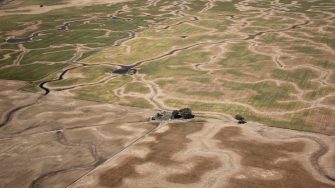
Date: Wednesday, November 9, 2016
Project: Eastern Australian Waterbird Survey
Observer: Richard Kingsford
We spent a beautiful crisp morning surveying the large Victorian lakes of the Murray-Darling Basin, gently bouncing every now again, courtesy of a 16 knot southerly. The new plane with all its navigational equipment makes the task of navigation relatively easy.
First off – the salt lakes west of Swan Hill, including the now famous Lake Tyrell for Chinese tourists. The water is highly saline, producing great reflections which have now become an international tourism site. Andrea (LBO or Left Back Observer) informed us that some tourists were strictly following the site location on Google Earth and getting bogged in the middle of the lake until the Victorian government agency had to put up some interpretative signs. Despite more than half of the lake covered by water, there was not a waterbird in sight. Clearly there is just no waterbird food.
Saline waters of Lake Tyrell
Surveying Lake Tyrell
Next – Lake Albacutya and Lake Hindmarsh. Both get water from the Wimmera River, which seldom flows. But we knew from the floods around Horsham and our survey a couple of weeks ago, across survey Band 2 and the Wimmera, that there was water flowing strongly in the river. It was no surprise that Lake Hindmarsh had water but there was not enough to get to Lake Albacutya. Perhaps later in the year. There were a few swans nesting and several hundred teal.
Lake Hindmarsh
Surveying Lake Hindmarsh
Lake Hindmarsh
From here onto Lake Buloke – one of the main sites for duck shooting in Victoria. On the way we could see the river channels in the cleared farmland. There were large areas of crops under flood in this part of Victoria. Lake Buloke had been dry for a while and it was good to see it flooded. It can have tens of thousands of waterbirds. Today it had hundreds of teal and a range of other different species.
Streams in farmland
Lake Buloke
Surveying Lake Buloke
Lake Buloke
We finished our morning flight ‘snaking’ around the Kerang Lakes. These are a special group of freshwater and salt lakes which vary considerably in their water chemistry, invertebrates, vegetation and consequently waterbirds. They can be ‘brimming’ with waterbirds, particularly when there is not much other wetland habitat around. We didn’t see many waterbirds today.
Surveying Lake Bael Bael, part of the Kerang system
Lake Bael Bael
We worked our way through the string of lakes, from west to east. Most had only a few waterbirds until we got to the most easterly three lakes: Third Lake, Middle Lake and Reedy Lake. On Middle Lake, there were 5,000-10,000 straw-necked ibis breeding, about 40 royal spoonbills and a few Australian white ibis. Reedy Lake had a small colony of white ibis and some straw-necked ibis breeding.
Colony of straw necked ibis breeding on the Kerang Lakes
We finished the morning back at Swan Hill, where we refuelled.
We went north, flying over the River Murray, on to the Lachlan’s Great Cumbung Swamp, one of the spectacular wetlands of the Murray-Darling.
The flood had extended well beyond the reedbeds and main channel of the Great Cumbung Swamp, down into the forests. There were pairs of grey teal, flocks of ibis and Pacific herons scattered throughout the flooded forest. The only way to survey this vast area was with transects, 200 m wide back and forth across the floodplain.
Great Cumbung Swamp
Surveying the forests and channels of the Great Cumbung Swamp
Surveying the reedbeds of the Great Cumbung Swamp
Great Cumbung Swamp
Once we had finished this great area, we had a chance again to see the amazing network of channels across the Booligal system, water spreading like tentacles across the dry landscape and bring it to life. This time we were higher up on our way to Lake Brewster.
Channels of the Booligal Creek system
We then went on to the newly filled Lake Brewster which is used to store water for irrigation downstream. It is a huge lake which had a few hundred waterbirds, including about 30 black swans with their cygnets. The other great sight were the pelicans which traditionally nest on the islands that jut out into the lake. There were a few hundred breeding in the colony.
Lake Brewster
Pelican colony on Lake Brewster
From here, we surveyed Lake Cargellico and a small lake further north, Banar Lake. Both lakes were considerably larger than their usual full level. Banar Lake was a surprise with hundreds of grey teal and a wide range of different waterbird species, even some magpie geese and whiskered terns breeding in a colony. We finally finished the day at Parkes.
